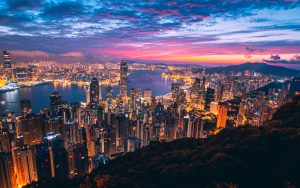60 East Asia: Urban Geography I – Entrepôt ~ Hong Kong
Entrepôt

For a mini-series of several chapters, we address the concept of the entrepôt, a particular type of trading city.
.
As seen in trading cities formerly in the British Empire
East Asia – Hong Kong
A concept of Urban Geography is the entrepôt, also an economic term. In a series of chapters, we will examine four examples of entrepôt cities that also were pieces of the British Empire. Thus, the sub-title of our chapter is Asian trading cities formerly in the British Empire. Here we consider the East Asian city Hong Kong, a superb example of an entrepôt. Although we highlight British colonial cities in these chapters, the word entrepôt is French for warehouse.
An entrepôt is a point of transshipment. That is, this type of city is located advantageously where export and import take place; however, not only in terms of products arriving and products departing, but importantly as the location where imports are sorted and repackaged for export. It is very likely that an entrepôt is an ocean seaport, though it is possible that a point of transshipment could be an intersection of highways, railroads, airports, and/or rivers. Roads, railroads, and airports are modern transportation hubs, whereas an entrepôt often has a lengthy history of trade, being founded as a settlement long ago. This preceding historical advantage favors the ancient seafaring trade; thus, again we note that seaports have an advantage in becoming entrepôts. Here we will compare and contrast entrepôts in four of our regions of the Eastern World.
| British Name | Other Names | Name means | Settled | British Takeover | Sovereignty | Population (in millions) |
|---|---|---|---|---|---|---|
| Hong Kong | was Hongkong | fragrant harbor | Stone Age | 1841 | 1997 | 5.7 |
| Singapore | lion city | 1000+ years ago | 1824 | 1965 | 7.3 | |
| Kollam, India | was Quilon | pepper | 2000+ years ago | 1795 | 1941 | 0.4 |
| Aden, Yemen | ancient | 1839 | 1967 | 0.86 |
Hong Kong
The city of Hong Kong is quite an unusual place, first as a splendid example of an entrepôt and second as a nearly unique case of “one country, two systems.” Along with Singapore in Southeast Asia, Hong Kong in East Asia represents the entrepôt concept perfectly. Along with the adjacent island city Macao (Macau), Hong Kong has a special designation in China’s territorial governance system. Both cities are Special Administrative Regions of the People’s Republic of China. This designation provides these cities with specific political and economic rights and practices that differ from those seen in the rest of communist China, although these rights have been violently tested in Hong Kong in recent years of political activism and mass protests.

Archeological evidence indicates human presence on Hong Kong as far back as the Stone Age. For centuries the island held a modest population that busied itself economically in fishing and in pearl harvesting. Eventually incorporated into the territories of Chinese dynasties, Hong Kong Island and a portion of the adjacent Kowloon Peninsula progressively developed as a trading location. European trading ships were eager to obtain Chinese products such as silk, porcelain, and tea. However, at that time Chinese merchants had little interest in European products. Seeking to balance trade more evenly, Britain began hauling opium from India to China in order to offer a product for marketing in China. The opium trade flourished in China, but was the cause of societal problems. In 1842 after the First Opium War, the Qing Dynasty ceded Hong Kong to Britain. Chinese losses in in the Second Opium War let to Britain gaining land on the Kowloon Peninsula.
Subsequently in 1898, Britain signed a 99-year lease for the whole of what is now Hong Kong. The lease gained a new sense of importance upon the establishment of communism in China in 1949. For about a half-century, Hong Kong (and its neighboring Macao) would be small bastions of capitalism on the periphery of a large communist country.
Hong Kong’s excellent natural harbor provided port access for foreign ships, so that Britain could expand the location’s developing trade market, propelling it to become a very busy entrepôt. Like Singapore, Hong Kong is too small to have natural resources, so acting as a trading center became a valuable strategy. Hong Kong does import raw materials and then provide value-added manufacturing, but also practices large volumes of reexporting or transshipment, the fundamental aspect of an entrepôt.

During the 99-year lease, China and the United States surpassed Britain as the major traders with Hong Kong. Though China’s relationship with Hong Kong changed after the lease expired, the “one country, two systems” policy allowed China to continue to trade heavily with Hong Kong, though now technically not as foreign trade. Free trade is essential to Hong Kong’s economy, as tariffs are levied only on four products – hard alcohol, tobacco, oil, and methyl alcohol. Financial services including the Hong Kong Stock Market, tourism, and gambling additionally are major aspects of the economy. Hong Kong is one of the world’s most crowded locales, prompting property values to be sky high and causing the city to have a spectacular skyline. In fact, Hong Kong has more skyscrapers than any other city in the world, even 75% more such towering structures than New York City.
Did you know?
Macau has a parallel system to that of Hong Kong, but was a Portuguese territory, also leased from China.
A 99-year lease was a notion of common law historically. Though not for forever, such a long lease certainly extended past the lifespan of anyone who signed the lease, thus for signatories a
99-year lease essentially meant forever.
Surprisingly, the Tanka boat people continue to practice small-scale fishing in Hong Kong, thus maintaining the economic habits of generations of their people.
Cited and additional bibliography:
Chow, Chapman. Johnston Road, Wan Chai, Hong Kong SAR, China. 12 June 2020, https://unsplash.com/photos/Yax3uuRP6Lo.
“Hong Kong.” Forbes, https://www.forbes.com/places/hong-kong/.
“Hong Kong’s History: From Backwater to Trading Metropolis.” France 24, 28 June 2022, https://www.france24.com/en/live-news/20220628-hong-kong-s-history-from-backwater-to-trading-metropolis.
Zhu, Simon. Hong Kong. Unsplash, 10 Sept. 2018, https://unsplash.com/photos/4hluhoRJokI.

